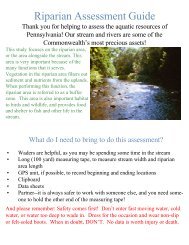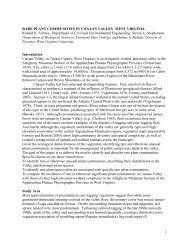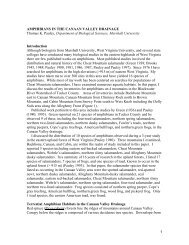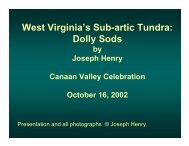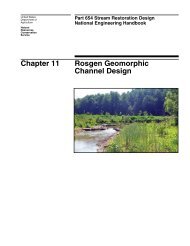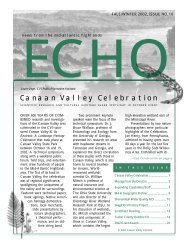1 PREHISTORY OF CANAAN VALLEY: AN ECOLOGICAL VIEW ...
1 PREHISTORY OF CANAAN VALLEY: AN ECOLOGICAL VIEW ...
1 PREHISTORY OF CANAAN VALLEY: AN ECOLOGICAL VIEW ...
You also want an ePaper? Increase the reach of your titles
YUMPU automatically turns print PDFs into web optimized ePapers that Google loves.
2002). In June 2002, over 200 shovel test pits yielded 15 prehistoric artifacts,<br />
including three types of chert flakes and a fragment of a bifacial tool (Robert F.<br />
Hoffman, pers. comm.). Based on local lithology, the chert is probably not local.<br />
Although the artifacts could not be affiliated with a specific culture, the lack of<br />
ceramics is consistent with an Archaic culture (Hoffman, pers. comm.).<br />
The pattern of lithic scatter suggests the site hosted at least two brief<br />
stopovers for hunting and curation of stone tools. Neither fire-cracked rock,<br />
ground or stone pecked stone tools, pottery sherds, nor evidence of a village or<br />
base camp were found.<br />
Although four projectile points had previously been found near this site, this<br />
seems to be the first published report of prehistoric artifacts in Canaan Valley.<br />
Why have so few artifacts been found in the Valley? Obvious possibilities include<br />
inadequate archeological sampling and scant prehistoric use. I will discuss this<br />
more in following sections.<br />
The Canaan Valley site is an example of a small lithic scatter, the most<br />
common site type in the uplands (Turner 1996, Wall 1996). Other lithic scatter<br />
sites have yielded primary reduction, secondary, and retouch flakes, and seem to<br />
have supported tasks like stone procurement, biface reduction, and tool<br />
resharpening (Tourtellotte 1996, Custer 1996). Upland lithic scatters may have<br />
been left by specialized parties who knew the area's resources and used the<br />
uplands for procurement tasks (Haynes 1996).<br />
Both the general patterns of space use during the major prehistoric periods and the<br />
specific findings at local sites suggest that prehistoric people occupied Canaan Valley for<br />
short periods.<br />
Why did prehistoric people visit Canaan Valley?<br />
Prehistoric people may have used Canaan Valley for several possible reasons; including<br />
plentiful water, escape from parasites, gathering of psychoactive plants or specialized<br />
materials for baskets, and refuge from aggressive bands, but possibly the most significant<br />
were acquiring stone and food.<br />
Stone<br />
Prehistoric knappers made tools by removing flakes from a stone by hitting it with a<br />
harder stone, or with a bone (Gardner 1986). In some cases, the flake was the desired<br />
tool; in other cases the piece remaining, or core, would be fashioned into a tool.<br />
In the East, raw forms of valued stone appear to have anchored centrally based<br />
wandering societies (Fagan 2000), a relationship that may explain a strong statistical<br />
correlation between Paleo-Indian sites and lithic sources (Bush 1996). If certain kinds of<br />
stone were needed for specific applications, the location of material would have restricted<br />
the distribution of people, or to have caused them to go great distances to acquire it<br />
(Haynes 1996). In contrast to the various kinds of useful stones in the Ridge and Valley<br />
province, only Greenbrier chert was available west of the Allegheny Front (Brashler<br />
1984, Haynes 1996) (Fig. 1).<br />
High quality chert deposits almost always show evidence of prehistoric use. The 3<br />
chert sites on Cheat Mountain described above are examples of quarries, defined as<br />
camps occupied for the extraction of rock from outcrops (Turner 1984).<br />
7





